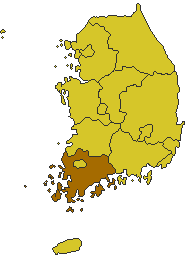Yeosu–Suncheon rebellion
The Yeosu–Suncheon rebellion,[1] also known as the Yeo-Sun incident, was an October 1948 rebellion that took place in Yeosu, Suncheon, and surrounding towns, South Jeolla against the fledgling South Korean Syngman Rhee government largely cued by that government's suppression of the Jeju Uprising and refusal of Yeosu soldiers to help suppress the rebellion.[2] In Yeosu, the rebelling South Korean soldiers seized weapons and took control of the town. The residents paraded through the town holding red flags. They restored the town people's committee, and tried and executed a number of police, officials, and landlords. The rebelling soldiers increased between 2,000 and 3,000, and massacred rights families and Christian youth.[3] After one week the South Korean army overwhelmed the rebels.[4] The matter was reviewed by the South Korean Truth and Reconciliation Commission, which found that government forces killed between 439 and 2000 area civilians.[2] U.S. forces played a role in suppressing the rebellion: U.S. commanders planned and directed the military operations, U.S. military advisors accompanied all ROK units, and U.S. aircraft were used to transport troops.[5]
Park Chung-hee, who would later become the president of Korea, participated in the rebellion. It is alleged, however, that he was punished leniently in exchange for agreeing to hunt down those involved.[6]
See also
References
- ↑ http://tripleaincorporated.blogspot.fr/2014/04/le-yeo-sun-incident-repetition-morbide.html?q=YEO+SUN
- 1 2 "439 civilians confirmed dead in Yeosu-Suncheon Uprising of 1948 New report by the Truth Commission places blame on Syngman Rhee and the Defense Ministry, advises government apology". Hankyoreh. 8 January 2009. Retrieved 15 February 2009.
- ↑ Stueck, William. The Korean War in world history. Univ Pr of Kentucky. p. 39. ISBN 0-8131-2306-2.
- ↑ Hart-Landsberg, Martin (1998). Korea: Division, Reunification, & U.S. Foreign Policy. Monthly Review Press. pp. 87–88.
- ↑ Hart-Landsberg, Martin (1998). Korea: Division, Reunification, & U.S. Foreign Policy. Monthly Review Press. p. 88.
- ↑ Cumings, Bruce (1981). The Origins of the Korean War, Liberation and the Emergence of Separate Regimes, 1945-1947. Princeton University Press. p. 266.
External links
- Families commemorate 8,000 civilian victims the Korean War at Jogye Temple Bereaved family members demand a government apology and compensation for civilian victims Hankyoreh Dec.15,2009
- (Korean) 사설 여순사건 60년에 위령탑 하나 없으니 Kyunghyang Shinmun 2008-10-21
